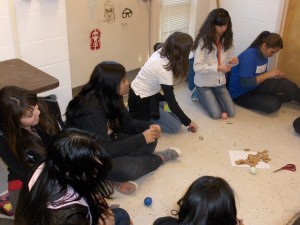From Struggle, Growth: How Students are like Butterflies
Heather Cook is a volunteer Citizen Teacher at De Vargas Middle School in Santa Fe, NM. Follow her blog here.  I knew it would be a challenge, but I was excited too. I looked forward to my class of 12-year-olds taking up a form of lacemaking that was last popular when their great-grandmothers were 12. I also knew from hard-won experience that they would face a steep learning curve. Once you learn the basic stitch, it is very simple. But mastering the basic stitch is a challenge that leads many adults to throw up their hands in despair and curse the scoundrel who invented this hellish craft.
I knew it would be a challenge, but I was excited too. I looked forward to my class of 12-year-olds taking up a form of lacemaking that was last popular when their great-grandmothers were 12. I also knew from hard-won experience that they would face a steep learning curve. Once you learn the basic stitch, it is very simple. But mastering the basic stitch is a challenge that leads many adults to throw up their hands in despair and curse the scoundrel who invented this hellish craft.
I also knew that the payoff would be high: Well-earned self confidence, patience, determination, a new skill, potentially a new hobby if they kept it up, and clear bragging rights over their friends.
Tatting is a form of lacemaking made with a ball of thread and either two hand-held shuttles or a long needle. It is great for making jewelry, decorations, edgings, and much more. Currently, several of the girls are churning out earrings while the boys are determined to get good enough to make rosaries.
 While watching these brave (and sometimes frustrated) pre-teens attempt to conquer this time-honored art, I have been struck by their resemblance to butterflies. Not in how they dress in bright colors, though they do, or in that they flit from flower to flower gathering nectar, though that is on their minds. Rather, in that the struggle to learn something new is akin to the process of a butterfly's birth.
While watching these brave (and sometimes frustrated) pre-teens attempt to conquer this time-honored art, I have been struck by their resemblance to butterflies. Not in how they dress in bright colors, though they do, or in that they flit from flower to flower gathering nectar, though that is on their minds. Rather, in that the struggle to learn something new is akin to the process of a butterfly's birth.
Have you ever watched a butterfly break out of its cocoon? It is slow and tortured work. The butterfly has to fight hard, take many breaks and claw his way into the light. If you were watching, you might be tempted to give the little fellow a hand; maybe make the crack wider to give him more space. However, it turns out that providing a shortcut would kill the newborn butterfly. The struggle itself is necessary for life. In straining against the cocoon, certain essential fluids are pushed out into the wings, and if you help him get out, the wings will not fully develop and the butterfly will die.
 Every time we learn something new, we struggle. Whether it is tatting or chemistry or balancing a checkbook. It is in this struggle that we learn who we are, what reserves of strength and character we have. We learn how to overcome difficulties and what it takes to succeed.
Every time we learn something new, we struggle. Whether it is tatting or chemistry or balancing a checkbook. It is in this struggle that we learn who we are, what reserves of strength and character we have. We learn how to overcome difficulties and what it takes to succeed.
When we struggle hard to make something, learn something, become someone new, we not only gain that skill or knowledge, we gain something even more valuable: We grow and live more fully. The next time these kids try to learn something difficult, they can look back at this experience, remember what it took to succeed, and think, "because I learned tatting, I can do this too." That is the power of the butterfly.
The next time you are tempted to hand your student the answer or give them a shortcut to success, remember the butterfly's life and death struggle and remember that your student too is struggling for her life.
Celebrate the butterfly!